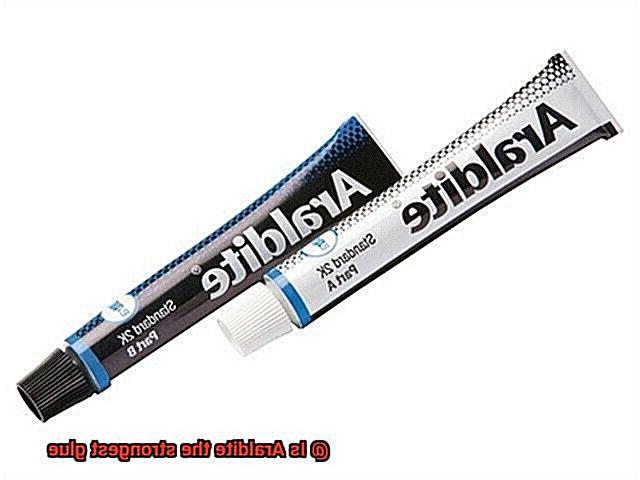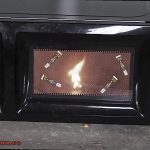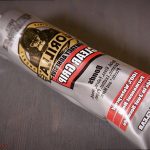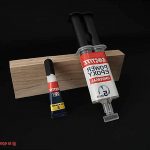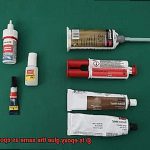Are you tired of using flimsy glues that can’t withstand the pressure and tension of your projects? If so, you might have heard about Araldite, the adhesive that’s claimed to be the strongest on the market. But is it really as powerful as people say?
Araldite is a two-part epoxy adhesive that was first introduced in the UK back in 194It’s composed of a resin and hardener that are mixed together to create an incredibly robust bond. This glue is perfect for fixing broken ceramics and glass, bonding metals and plastics, and so much more.
But what sets Araldite apart from other adhesives? Some folks argue that it has a higher bond strength than its competitors, while others believe its power depends on the materials being bonded.
In this blog post, we’re going to explore the science behind Araldite and its claim to be the “strongest” glue on the market. We’ll dive into its chemical composition and properties, comparing it to other types of adhesives. Additionally, we’ll take a look at some examples where Araldite has been used successfully and where it may not be your best bet.
So whether you’re an avid DIY-er or a professional looking for the best adhesive for your project, keep reading to learn more about Araldite and find out if it truly lives up to its reputation as the strongest glue available.
Advantages of Araldite
Contents
- 1 Advantages of Araldite
- 2 Strength and Durability of Araldite
- 3 Comparison to Other Adhesives
- 4 The Factors that Affect the Strength of an Adhesive
- 5 Testing Different Adhesives to Determine the Strongest Bond
- 6 Pros and Cons of Using Araldite
- 7 Uses for Araldite in Different Industries and Applications
- 8 Alternatives to Araldite for Stronger Bonds
- 9 Conclusion
When it comes to bonding materials, Araldite is a two-part epoxy adhesive that stands out from the rest. Its advantages are numerous, making it a popular choice for various industries.
One of the top advantages of Araldite is its strength and versatility. It can bond metals, ceramics, glass, rubber, and many plastics, making it a versatile choice for different applications. The bond it forms is also waterproof and resistant to water and many chemicals such as oil, gasoline, and solvents.
Araldite’s long working time is another feature that sets it apart from other adhesives. This allows users to adjust and position the materials being bonded before the adhesive sets. This ensures a precise fit and a strong bond.
The temperature resistance of Araldite is also noteworthy. It can withstand temperatures ranging from -60°C to +180°C, making it an ideal choice for use in extreme environments. This makes it suitable for applications where high temperatures or extreme cold can be expected.
In addition to these advantages, Araldite has excellent chemical resistance properties. Once cured, it forms a strong bond that is resistant to various chemicals such as acids, bases, solvents, and oils. This makes it perfect for use in harsh industrial environments.
Overall, Araldite offers a range of advantages over other adhesives due to its strength, versatility, chemical resistance, long working time, and temperature resistance. It’s no wonder why it’s become a go-to choice for many different applications that require a strong and durable bond.
However, it’s important to keep in mind that the strength of an adhesive depends on several factors such as surface preparation, curing time and temperature, and load-bearing capacity required for the application. While Araldite generally has a stronger bond compared to other types of adhesives such as cyanoacrylates and polyurethanes, there are also other epoxy brands that claim to be stronger than Araldite.
Strength and Durability of Araldite
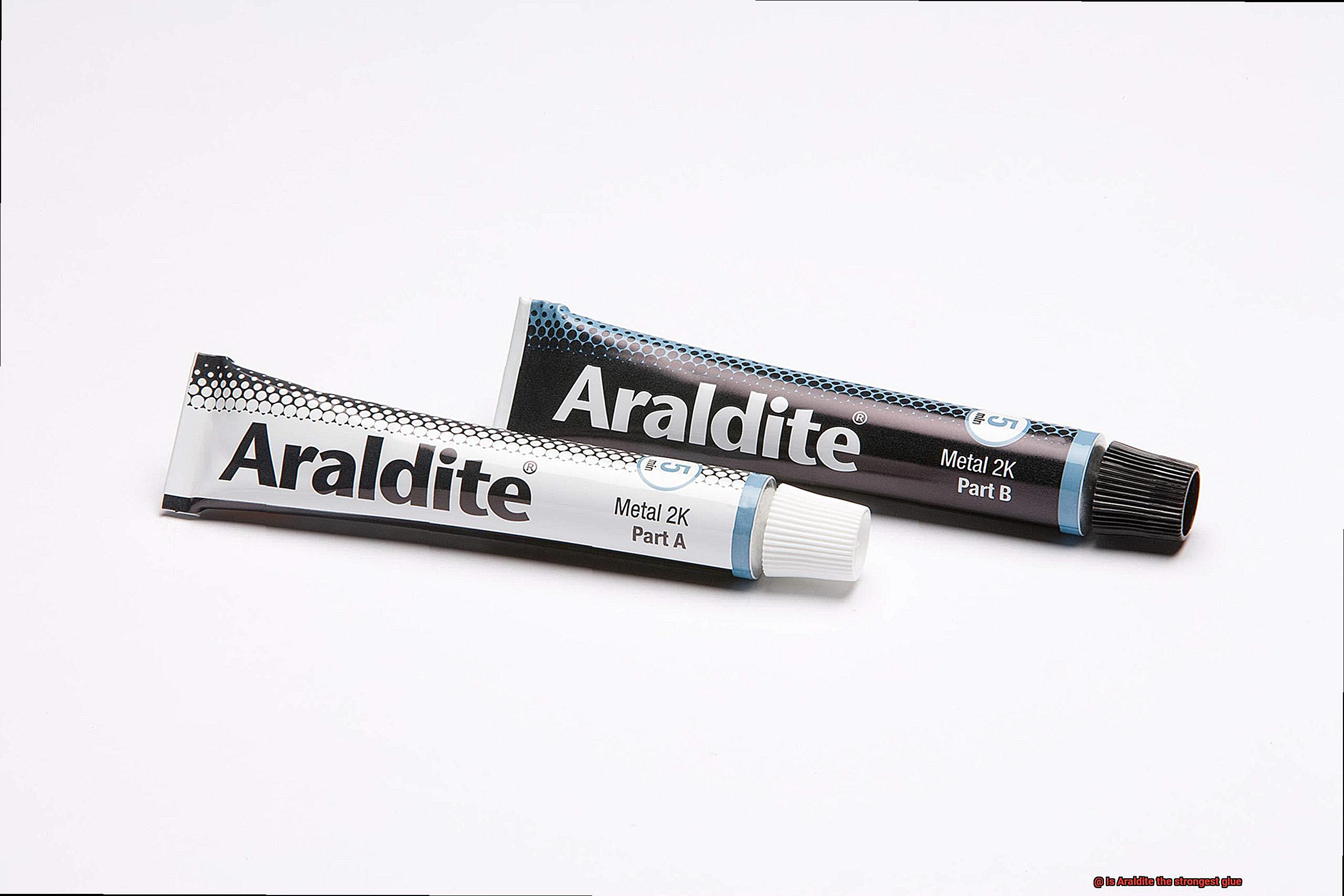
What sets Araldite apart from other adhesives is its chemical composition. The resin and hardener combine to create a high-strength polymer that can withstand high stress and strain. This means that once Araldite bonds two surfaces together, they will remain strong and secure.
But it’s not just about the initial bond. Araldite’s curing process is equally impressive. During the curing process, the adhesive penetrates the surface of the materials being bonded, creating a strong mechanical bond. This ensures that the bond remains strong even under heavy loads or extreme conditions.
Araldite’s durability is another key feature that makes it stand out among other adhesives. It is resistant to water, chemicals, and heat, making it ideal for use in harsh environments. It can handle temperatures ranging from -60°C to 150°C, making it suitable for use in both hot and cold climates.
In addition to its strength and durability, Araldite is also highly versatile. It can bond a wide range of materials, including metal, wood, ceramics, glass, and plastic. This makes it a popular choice in industries such as construction, automotive, and aerospace.
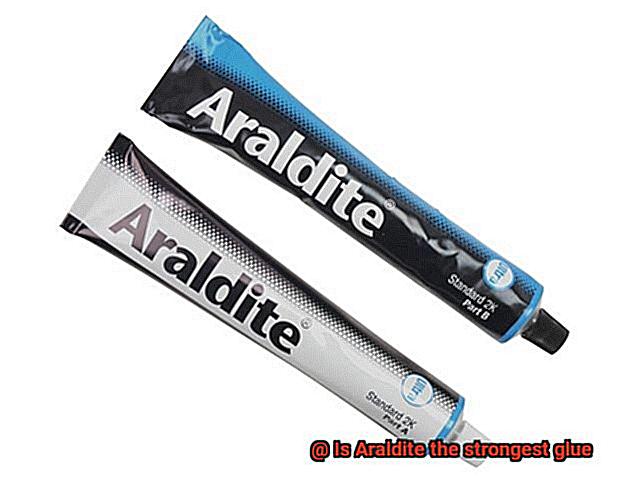
Comparison to Other Adhesives
While there are a plethora of adhesives available on the market, it is essential to compare them to determine which is the strongest. Let’s take a look at how Araldite fares against other popular adhesives such as cyanoacrylate, epoxy, and silicone glue.
Firstly, let’s talk about cyanoacrylate or superglue. It dries quickly and forms a strong bond between surfaces but its brittleness makes it unsuitable for use on flexible materials. In comparison, Araldite can handle more tension and impact making it a better choice for heavy-duty repairs.
Epoxy is another two-part adhesive that requires mixing before use. It is known for its strength and durability, making it a popular choice for industrial applications and heavy-duty repairs. However, Araldite has been proven to be stronger in extreme conditions like high temperatures or harsh chemicals.
Silicone glue, often used for sealing and bonding in plumbing and automotive applications, forms a strong, waterproof bond that can withstand extreme temperatures and harsh chemicals just like Araldite. However, when it comes to strength and impact resistance, Araldite still comes out on top.
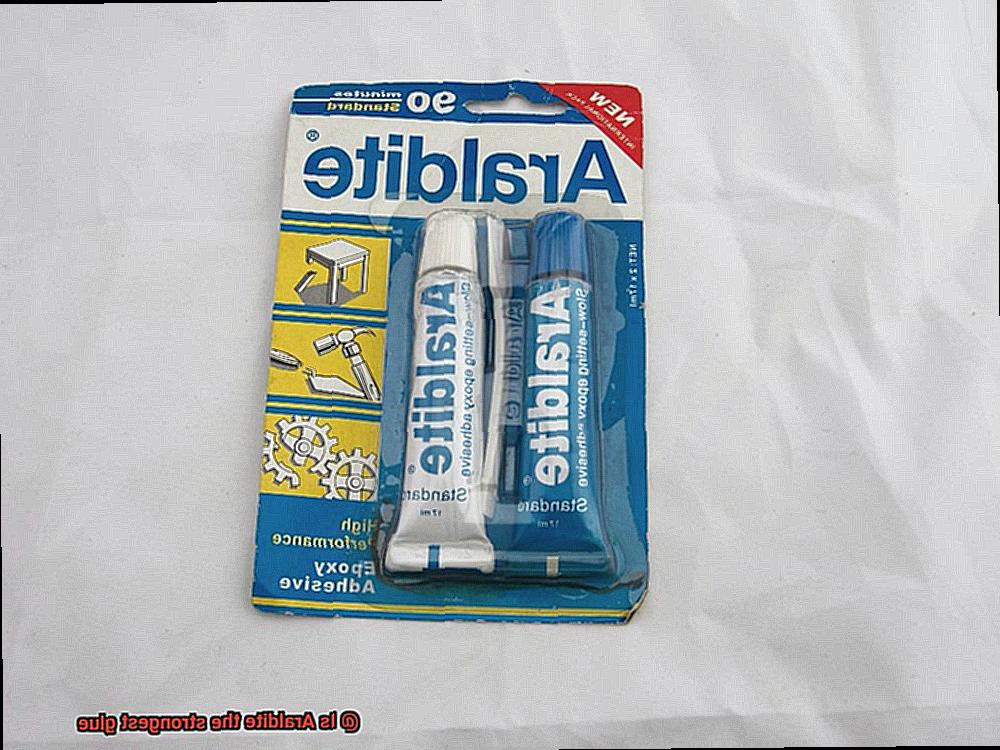
The Factors that Affect the Strength of an Adhesive
First and foremost, the type of adhesive used is crucial. There are many different types of adhesives, each with unique properties and strengths. Choosing the right adhesive for the job is key to ensuring a strong bond. For example, a wood glue may not be suitable for bonding metal surfaces.
Next up is surface preparation. The surfaces to be bonded should be free from any dirt, dust, oil, or grease. Any contaminants on the surface can weaken the adhesive bond. It’s also essential to roughen or etch the surfaces to increase the surface area for better adhesion.
Environmental conditions can also affect the strength of an adhesive bond. High temperatures or humidity levels can alter the chemical properties of the adhesive and lead to a weak bond over time. So it’s important to consider these factors when choosing an adhesive and during bonding.
Pressure applied during bonding is another critical factor that affects adhesive strength. Too much pressure can cause excess adhesive to squeeze out, resulting in a weak bond. Similarly, not allowing sufficient time for curing before applying stress can result in a weak bond.
Lastly, the thickness of the adhesive layer applied can impact the strength of the bond. Applying too little adhesive may result in a weak bond, while applying too much can cause excess to squeeze out and weaken the bond.
Testing Different Adhesives to Determine the Strongest Bond
Testing different adhesives to determine the strongest bond is crucial for any DIY project or industrial application. It’s a fascinating process that involves selecting a variety of adhesives, materials, and conducting various tests to find the ultimate bonding solution.
Let’s start by selecting a range of adhesives for testing. Epoxies, polyurethanes, cyanoacrylates, and more – each adhesive has unique properties that affect its strength and bonding capabilities. By testing multiple options, you can find the adhesive that provides the strongest and most durable bond for your particular application.
With adhesives selected, it’s time to choose materials for bonding. Whether it’s metals, plastics, wood, ceramics, or any other commonly used material in everyday life – they can all be used for this purpose. Thoroughly cleaning and preparing the materials is essential to ensure a strong bond is formed.
Once the materials are prepared, follow the instructions for each adhesive carefully to ensure proper curing and bonding. After the glue has cured, you can test the strength of the bond using various methods.
One popular method is a tensile strength test. This involves using a machine to pull the materials apart until the bond breaks. The force required to break the bond is measured and recorded for each adhesive tested. Other tests may include shear strength tests or impact tests.
It’s important to note that several factors can affect an adhesive’s strength. The type of materials being bonded, environmental conditions such as temperature and humidity, and how well the adhesive was applied can all impact the strength of the bond. Therefore, it may be necessary to conduct multiple tests in various conditions to determine which adhesive is truly the strongest.
Pros and Cons of Using Araldite
This two-part epoxy adhesive has been used for decades in various industries, such as automotive, aviation, and construction. But before you dive in and use it for your next project, let’s take a look at its pros and cons.
Firstly, let’s discuss the pros of using Araldite. Its exceptional bonding strength is unparalleled, making it perfect for creating a permanent bond between various surfaces like metal, ceramics, plastics, and even wood. Once cured, it can withstand high temperatures, water exposure, and chemicals – ensuring longevity and durability. Araldite is also versatile and can be used for a range of applications – from bonding metal parts to fixing household items like ceramics and glass. And thanks to its two-part system, it’s easy to use, sets quickly, and creates a strong bond within minutes.
However, like any other product, Araldite comes with its cons. Firstly, it contains harmful chemicals that can be dangerous if ingested or inhaled. It is crucial to use this adhesive in a well-ventilated area and follow safety precautions to avoid any potential hazards. Secondly, it takes 24 hours or more to fully cure which means that the bonded surfaces cannot be moved or stressed during this period. This can be inconvenient if you need your project completed quickly. Thirdly, once cured, it becomes difficult to remove without damaging the surfaces it is bonded to – so make sure you’re committed to the bond before using Araldite. And finally, Araldite is relatively more expensive than other adhesives available on the market.
Uses for Araldite in Different Industries and Applications
When it comes to bonding materials, Araldite is the go-to adhesive for professionals in a variety of industries. With its unparalleled strength, durability, and versatility, Araldite has become a staple in different applications.
In the automotive industry, Araldite is commonly used to bond metal, plastic, and composite materials. It has proven to be a reliable adhesive for exterior parts like bumpers and spoilers, as well as engine components such as cylinder heads, valves, and camshafts. The ability of Araldite to withstand high temperatures and chemical exposure makes it an excellent choice for any automotive application.
Meanwhile, the aerospace industry heavily relies on Araldite to bond composite materials such as CFRP and GFRP. With its excellent bonding properties, it’s no wonder why Araldite is a popular choice in the aerospace industry. Its ability to provide strength and durability is vital when it comes to aircraft structures and components.
In the construction industry, Araldite is used in bonding a wide range of materials like wood, metal, concrete, and plastic. It is commonly used to bond facades, windows, doors, and furniture. Araldite can withstand extreme temperatures and weather conditions making it a reliable adhesive for construction applications.
The electronics industry utilizes Araldite for its ability to bond electronic components like circuit boards and semiconductors. With its excellent electrical properties, Araldite is an ideal choice for bonding high conductivity components.
In the marine industry, Araldite is widely used to bond boats, yachts, and other watercraft. It can bond hulls, decks, and other structural components that can withstand exposure to saltwater and other harsh marine environments. Its ability to provide strength and durability makes it an excellent choice in different marine applications.
Lastly, the medical industry uses Araldite to bond medical devices like implants and prosthetics. Its biocompatibility and ability to withstand sterilization make it a reliable adhesive for medical applications.
Alternatives to Araldite for Stronger Bonds
As a connoisseur of adhesive bonding materials, I’m often asked about the best alternatives to Araldite for creating stronger bonds. While Araldite is a powerful adhesive, there are other options available that may provide even stronger bonds in certain situations.
One of the most popular alternatives to Araldite is epoxy resin. This two-part adhesive creates a chemical bond that is incredibly strong and can be used on a variety of materials including metal, wood, and plastic. Epoxy resin is also resistant to water and chemicals, making it a popular choice for industrial applications where durability is key.
Another option is cyanoacrylate glue, or super glue as it’s commonly known. This type of adhesive creates a bond by reacting with moisture in the air and can be used on a variety of materials such as metal, ceramic, and rubber. Cyanoacrylate glue sets quickly and forms an exceptionally strong bond that’s perfect for small-scale projects.
For applications where temperature resistance is important, polyurethane adhesive may be the best choice. It can withstand extreme temperatures and is also resistant to water and chemicals. Polyurethane adhesive can be used on materials such as metal, wood, and plastic, making it ideal for automotive and construction applications.
Lastly, structural acrylic adhesive is another option for creating strong bonds. This type of adhesive can be used on materials such as metal, glass, and ceramics. It has the unique ability to absorb shock and vibrations, making it a popular choice for automotive and aerospace industries.
Conclusion
To sum up, Araldite is a two-part epoxy adhesive that has been in use for over seven decades and is touted as the strongest glue available. Its remarkable strength and versatility have made it a popular choice for a wide range of industries, including automotive, aerospace, construction, marine, electronics, and medical.
One of the key advantages of Araldite is its ability to bond metals, ceramics, glass, rubber, and many plastics. Moreover, it boasts a waterproof and chemical-resistant bond along with an extended working time. It can withstand temperatures ranging from -60°C to +180°C while exhibiting excellent chemical resistance properties.
When compared to other adhesives such as cyanoacrylate glue, epoxy resin, polyurethane adhesive, and structural acrylic adhesive – Araldite generally has a stronger bond due to its unique chemical composition. However, the strength of any adhesive also depends on factors like surface preparation, curing time and temperature as well as load-bearing capacity required for the application.
While Araldite does have several benefits such as exceptional bonding strength and durability in harsh environments – it comes with some drawbacks too. For instance, it contains harmful chemicals that require safety precautions during use. Additionally, it takes 24 hours or more to fully cure which may not be suitable for quick projects.
In conclusion – if you require a potent adhesive for heavy-duty repairs or industrial applications that demand durability in extreme conditions like high temperatures or harsh chemicals – look no further than Araldite.

